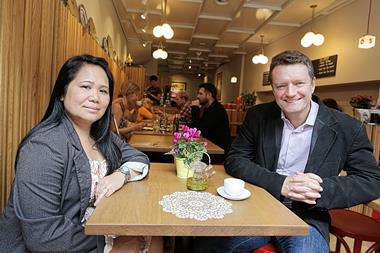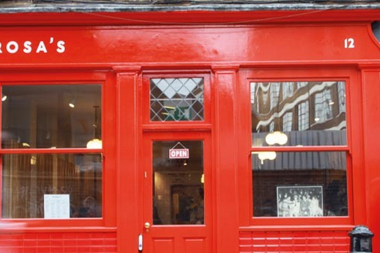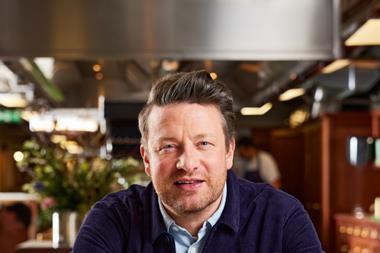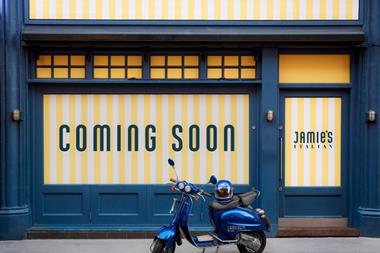The sale of her stake in Rosa’s Thai Café has not sated the Saiphin Moore’s appetite for the restaurant business. As well as her Lao Café concept, she is developing new brand, Slurp. Here, she talks to Sarah Sharples, of MCA’s sister title, Food Spark, about how far Thai food has come in London since she landed 14 years ago, the dishes she is proud to have put on the menu and her disinterest in a Michelin star.
Saiphin Moore loves noodles so much that she eats them every day for breakfast. No wonder then that she is in the middle of creating a new noodle restaurant brand named Slurp. The menu will be based around Asian noodles – mostly in soups – and the aim is to open the first location at the end of March.
“It’s a concept between my very young age in Thailand and also when I grew up in Hong Kong for 28 years, as they love noodles in Hong Kong and China,” she explains. “So maybe this is my last project and I’m going to turn it into a noodle chain. I can tell you it’s going to be so good.”
The new project comes after she sold her majority stake in Rosa’s Thai Cafe to private equity firm Trispan in June last year, although both she and her husband Alex remain involved in the business. Rosa’s is a bright light amidst hospitality’s current doom and gloom, having been ranked as one of the top three fastest-growing restaurant chains by the MCA/AlixPartners Growth company index 2017.
Aside from Rosa’s, Moore also realised her dream of bringing the food from her roots to London with the opening of Lao Cafe in 2017, where she is seeing diners embrace bugs.
Here, she talks to Sarah Sharples about how far Thai food has come in London since she landed 14 years ago, the dishes she is proud to have put on the menu and her disinterest in a Michelin star.
I started cooking rice when I was only 7 years old. My parents were farmers growing rice and vegetables in the jungle, so part of my job was to learn how to cook from my mum and my great gran and my gran.
I set up my first business in my family house. I turned the ground floor into the noodle shop at only 14 years old – so I was still going to the school at that time.
I got a job as a nanny in Hong Kong when I was 18, but it wasn’t for me. I used to go to a Thai shop for ingredients and I asked if there was a job opportunity to work in the grocery store. They had a restaurant across the road, so I would work for my employer and then go to the restaurant for a couple of hours to work. That was the time I started to think really seriously about food.
Then I got married and I set up my own business as a grocery shop and also doing takeaway, so I had 11 dishes. I sold that business and then set up the restaurant in Hong Kong called Tuk Tuk Thai in the market in central Hong Kong.
After 28 years, my three children were studying in England and I also wanted to move to a new place. I started selling my food in an office in London and I cooked it all in my kitchen in my little apartment in Wapping for about a year. Then we walked to Brick Lane and I saw the food stall at the Sunday market and I thought, oh my gawd, that is what I want.
My husband Alex saw a cafe called Rosa’s. It was really old and there was nothing there and they said there was a business opportunity. It became Rosa’s first site. At that time, we didn’t have enough money, so we set the restaurant up with a credit card. Alex left his business to come and help me. After a year, we found the second site in Soho and had to sell our house in Hong Kong.
We trained very good chefs at the first site, so then we could move them out when we got the new sites… Each chef is our partner. We give them a share option, for our head chef and manager.
One thing I’m so happy I created is the steamed butternut squash in seafood mousse. We mix the seafood with red curry paste, coconut milk, fish sauce and palm sugar, and then you chop the lime leaves and add the sweet basil. Then you add two eggs, mix until they are very smooth and put it all inside the butternut squash. It was a hit, every table ordered it.
When we opened the third restaurant, we thought about the timings of cooking dishes. The steamed seafood mousse took a long time, at least 15 minutes, when we can put something on the table in no more than five minutes, so we took it off the menu. I’m still so proud of that and I still have that dish in my cookbook. I think it’s for home use.
One menu item that took a lot of time for them to cook was a steamed fish, with lime juice, chilli, garlic, fish sauce and palm sugar. If you don’t use a high heat to steam them, it can have a very fishy smell. That dish was going so well with the Thai people, because they are used to that. But for Rosa’s, if we want to sell the steamed fish to a non-Asian, I don’t think they like it that much. Not that many like to eat the fish with bones and with the head on it, and this dish you have to have a whole fish. For us, it was really difficult to do.
We make pad Thai and that is one dish that I think we do best because we have our own recipe. I created this pad Thai sauce that I cannot describe as it’s my secret. It’s a bestseller. Once, we did a marketing thing where we sold it for £1 and we sold a million in that period. In one day during that time, 4,000 portions of Pad Thai were sold.
All the curry pastes are not from the package, they are all freshly made every week, and 400kg is sold each week.
A lot of people these days have tried to sell exactly what we sel l – like fresh spring rolls. I know it’s a Vietnamese dish, but in Thailand we also sell fresh spring rolls. Ours is different because of the sauce – again, it’s not a Vietnamese dipping sauce, this sauce I created when I had the takeaway in Hong Kong. It’s a peanut sauce that tastes of sweet and sour at the same time and a little salty. It is made from tamarind that comes from where I come from, a place called Phetchabun, and in March we are going to visit the farm where it is grown. There is palm sugar and soy sauce, along with roasted, crushed peanuts and a tiny bit of chilli powder. There are the herbs too we put in, which is a mix of Thai celery, mint, coriander and sweet basil.
I work on quality control, so almost two years ago we set up a central kitchen. Most of the sauces are made in London Fields. We have red curry, green curry, massaman, Penang, pad Thai, peanut and sweet chilli. We also make the chicken satay, fried spring rolls and pork skewers to make sure we deliver the same standard each time.
We also produce our own coconut milk, palm sugar and rice with farmers in Thailand and sell it at Rosa’s– we don’t work with a middleman. About 11 products come from Thailand and they are our own products, they are not a big brand name, but I choose the quality and choose to work and help my people.
People are more aware if people make shortcuts with Thai food. When I first moved here 14 years ago, most of the Thai food I ate was not authentic. That’s why, when I set up Rosa’s, I knew what was the weakest link about Thai food at the time. I knew with the green curry they didn’t use a real paste, but were using something like spinach juice to make it green or put peas or lime juice in – and it would make me mad.
I feel like Thai food is getting better and better because more people know about it and you can’t cheat them anymore. If you go to Rosa’s, we don’t adapt the taste, I don’t hold off with the spice, we give people the real thing and cook in the traditional way.
I have been everywhere trying to eat Lao food and it was always just an add on in a Thai restaurant. They have larb, papaya salad, but it’s not specialised. It made me feel that you need to set something up.
I’m so proud of Lao Cafe, it was my dream to have the food I grew up with and that is my comfort food.
Lao food is totally different to Thai food. There is spicy larb, curry, papaya salad and most of it is grilled. With curries, we never use coconut milk; it’s more a soup base with a lot of vegetables and herbs, so it’s very healthy.
The bug is the future. I’m trying to introduce insects in Lao Cafe as people are more aware of insects. I can see in Thailand now a lot of people have an insect farm. I think more and more people are open to eating bugs. We have a bug snack with crickets and grasshoppers, and people really like it.
Ingredients I’m working with include our ants eggs to put in our curry and pickled crab to put in our papaya salad. We use a lot of anchovy fish and a lot of herb juice – a lot of things people aren’t aware of.
The cuisine that all these Michelin-star places try to make with a small plate and beautiful food– my designer said I should take Lao Cafe in that direction, but I said I don’t want a Michelin star. I think Lao Cafe, in a couple of years it will be moving really fast as I’ve introduced people to the cuisine and they understand it now.
I can see a lot of other restaurants like Som Saa and Smoking Goat, when I set up the Lao Cafe pop-up and they hadn’t opened yet, they all came and tasted my Lao food, and now everything on my menu is on their menu. I am happy and proud that people see a good thing about Lao cuisine.
Article originally published on foodspark.com, a digital subscription service designed to inspire and inform innovation across the food industry.
For anyone needing to stay ahead of the culinary curve, Food Spark will offer immediate access to the emerging trends, ingredients, personalities and headwinds defining the future of food. Explore more content by visiting Food Spark or by requesting a demo: joinus@foodspark.com or 01293 610371.












































